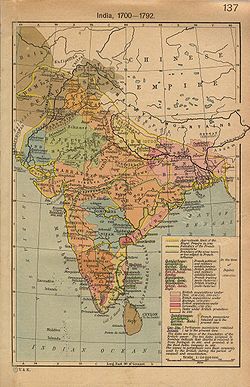Difference between revisions of "Mughal Empire"
Symorsebrown (talk | contribs) (Temp save) |
Symorsebrown (talk | contribs) (Amend description) |
||
| Line 37: | Line 37: | ||
=== Remuneration === | === Remuneration === | ||
Payment of the ''mansabdars'' by the emperor was by ''naqdi'' (cash) or the revenue of a ''jagir'' (land holding). Personal fortunes could not be passed to children but reverted to the emperor. This discouraged Amirs from investing in property and led to expenditure on extravagant lifestyles. | Payment of the ''mansabdars'' by the emperor was by ''naqdi'' (cash) or the revenue of a ''jagir'' (land holding). Personal fortunes could not be passed to children but reverted to the emperor. This discouraged Amirs from investing in property and led to expenditure on extravagant lifestyles. | ||
| + | ==== Jagir ==== | ||
| + | The ''Jagir'' was the right granted by the emperor to recover revenue from a tract of land. The grantee was called a ''Jagirdar''. | ||
| + | |||
| + | |||
== External links == | == External links == | ||
Revision as of 16:01, 26 March 2011
Contents
Mughal administration
The Mughal Empire originated in Central Asia and lasted from the reign of Babur beginning in 1526 to the exile of Bahadur Shah II in 1857. At its height it controlled most of the Indian subcontinent. FIBIS records contain many references to Mughal administration and officials so a brief description is given below.
Administrative system
The cohesion of the Mughal empire depended on the qualities of the emperor around whom everything revolved. The administration was given entirely at his whim to a hierarchy of subordinate officials. The posts were randomly appointed and the recipients had no specific training or examination unlike the Chinese civil service. More often than not they were gained through political manoeuvring and bribery. None of the posts was hereditary making the emperor's favour even more necessary.
Vakil
The Vakil was the royal deputy. It was a post filled only twice under the seven great Mughal emperors. Other ranks were in descending order:
Wazir
The Wazir (anglicised to vizier) was the second highest rank. He was the chief executive of the empire with varying powers. Again the post was not always filled.
Diwan
The Diwan was the finance minister responsible for collection of revenue and remittance of it to the imperial treasury. The office was sometimes combined the that of Vizier. The Diwani (revenue office) was conferred on the East India Company by Shah Alam in 1765. This greatly enhance the power of the British in India. In later years the term Diwan was also used for the prime minister of a princely state.
Mir Bakshi
The Mir Bakshi was the paymaster-general and the administrator of the army.
Chief Sadr
The Chief Sadr was the chief ecclesiastical officer/chief justice in charge of charitable and religious endowments.
Chief Kazi
The Chief Kazi was an Islamic scholar & judge and the expounder of canon law.
Muhtasib
The Muhtasib was the regulator of public business who controlled trade and enforced Islamic injunctions.
Mansabdar
The Mansabdar (lit. rank holder) was the lowest grade of official. They were divided into three functions: military, clerical and theological.
Amir
All Mansabdars were titled Amir (commander). They were graded in military fashion ranging from Commander of 7,000 to Commander of 20. Amir-i-Azam (greater nobles) commanded 7,000 to 3,000. Amir (noble) commanded 2,500 to 500. Mansabdar commanded 400 to 20.
Territory
At its zenith in the 17th century under Aurangzeb the empire was divided as follows:
Suba
The Suba (province) was the largest unit and there were 29 governed by a Subedar (governor) - not to be confused the Indian army rank Subadar. The Suba was subdivided in two ways - for revenue collection and for military administration.
Sarkar
The Sarkar (tax district) was a revenue subdivision of the Suba which contained a number of Parganas (sub-districts). The "Purgunnah" battalions in the Bengal Native Infantry were formed for revenue collecting duty. Sarkar was also a term used to denote the British Indian administration.
Faujdari
The Faujdari (military district) was a subdivision of the Suba, It was administered by a Faujdar.
Thana
The Thana was a sub-divion of the Faujdari and was overseen by a Thanedar.
Remuneration
Payment of the mansabdars by the emperor was by naqdi (cash) or the revenue of a jagir (land holding). Personal fortunes could not be passed to children but reverted to the emperor. This discouraged Amirs from investing in property and led to expenditure on extravagant lifestyles.
Jagir
The Jagir was the right granted by the emperor to recover revenue from a tract of land. The grantee was called a Jagirdar.
External links
Mughal Empire Wikipedia
Sarkar Wikipedia
Dewan Wikipedia
Qazi Wikipedia
Muhtasib Wikipedia
Mansabdar Wikipedia
Amir Wikipedia
Jagir Wikipedia
